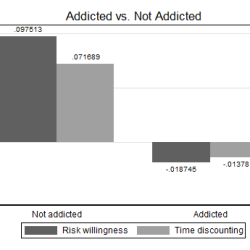“Science is not only a disciple of reason but, also, one of romance and passion.“ (Stephen Hawking)
The context of the study
Recently, the mass-media got interested in the effects of easy and cheap access to high-speed pornographic material over the internet (check out this wonderful article in the Economist). Yet, there is almost no scientific evidence on the effect of pronography on behaviour. So I thought: why not run a study with participants of NoFap®, the largest group of individuals trying to abstain from porn and masturbation?
And so it began…
People have been talking a lot about improvements in their relationships, their well-being and their lives in general after joining NoFap. Yet, people also have been talking a lot about scientific evidence on how masturbation/porn abstinence impacts their lives. Truth is, this evidence is still scarce. And I decided to change that. Stephen Hawking said science is as well a discipline of romance and passion: why not take him literally?
With an ever growing community of members of NoFap, a survey on user preferences, masturbation and porn abuse was overdue. This is why I wanted to make an attempt to plug the holes in masturbation research with a well-assembled survey. After all, wouldn’t it be great to substantiate the potential benefits of masturbation and porn abstinence with some solid scientific facts?
I thus contacted Alexander Rhodes, the founder of NoFap, and they agreed to facilitate a user survey in the community. The goal of the survey was threefold. First, it was intended to help the community to know its membership a little better. Second, backed by scientific evidence that “rebooting” affects the reward system in the brain, the survey was intended to help find out how this influences preferences for uncertainty and for time: It provides answers to the questions if masturbation and porn abstinence have an effect on the ability to delay rewards or on the ability to rationally assess risks. And third, questions on NoFap user experiences could help improve the quality of services offered to the community.
The study belongs to the field of behavioral economics. Behavioral economics (and here I just stole the definition from Wikipedia, but it nicely nails it down) studies the effects of psychological, social, cognitive, and emotional factors on the economic decisions of individuals and institutions and the consequences for market prices, returns, and the resource allocation. Behavioral economics is primarily concerned with the bounds of rationality of economic agents. Behavioral models typically integrate insights from psychology, neuroscience and microeconomic theory; in so doing, these behavioral models cover a range of concepts, methods, and fields.
In the current study, more specifically, I mainly analyzed how fapstincence influences two types of preferences of high economic relevance: uncertainty and time preferences. Uncertain decisions are defined as choices with some known (risk) or unknown (ambiguity) probability of yielding a positive outcome (as an example, you might imagine risky decisions as being decisions of the sort: You need a medical treatment, a surgery. The physician tells you that you have a 50% chance to get better afterwards. Would you do it? Now for ambiguity: the physician tells you that he does not know the probability that you will get better afterwards. Will you still do it?). Economists have pinpointed the core of these decisions and found a strong correlation of individual preferences over domains. If you are likely to invest your money in high-risk stocks, you are also more likely to undergo a high-risk surgery. I ran a stylized choice task in this study that has been shown to predict real life decision making under uncertainty.
Then there are time preferences. Classic economic theory predicts that I should not attach a different value to receiving $100 now and to receiving $100 two months from now, I should be indifferent. But behavioral economics (and commonsense) has shown that people have a so-called “discount factor”, valorizing future rewards lower than current rewards. I measured, again with a stylized task, the size of the discount factor of fapstronauts. More specifically, I measured the premium that is requested to delay a reward for one year. It has been shown (and if I write “it has been shown”, I did not provide any references for the sake of keeping it short and informative) that people who are better in delaying rewards perform better in life (in the sense that they get better grades in school, earn higher wages, etc.).
Fapstinence
Now you may wonder what all of this has to do with abstaining from PMO (abbreviation standing for Porn, Masturbation, Orgasm). As this (http://archpsyc.jamanetwork.com/article.aspx?articleid=1874574&resultclick=1) study shows, heavy porn consumption affects activity and gray matter volume in some regions of the brain, namely in the striatum. The connectivity between the reward system and another brain region, the dorsolateral prefrontal cortex, also is altered after long periods of heavy porn consumption. Yet these regions play also an important role in uncertain decisions (http://www.sciencedirect.com/science/article/pii/S1053811908006927) and in time discounting (http://www.sciencedirect.com/science/article/pii/S1053811908012093). I therefore hypothesize that when fapstronauts are, as they call it, “rebooting”, risk and time preferences will change. I expect that, when controlling for individual variability in sexual history, participants will at the beginning of a reboot have more problems delaying rewards than after one month, and that uncertainty preferences will also change (yet I have no clear hypothesis about the direction of the change, it may go both ways).
Survey Design
In short:
- Two surveys
- First survey starting 1st of November 2015 (“wave 1“)
- Second survey starting 1st of December 2015 (“wave 2“)
- Aim: comparing answers on Survey 1 with Survey 2 to find out how abstinence (or “rebooting“) influences preferences.
- Mainly:
- Risk preferences (How willing or unwilling are you to take risks?)
- Time preferences (How able are you to delay rewards?)
The survey was thus divided into two parts. The first part was released in November 2015. It asked questions about the participants, their history, their preferences, their attitudes toward masturbation and pornography, and the experiences they’ve had along the way. This section took about 10 to 15 minutes to complete.
The second part was released one month later. It asked the same questions (minus a few questions if one participated in the first survey) in order to assess how the preferences change over time. Participants were not required to take part in both parts of the survey.
The survey was completely anonymous.
Results of the First Wave
Main Findings
- The length of the longest streak participants performed before taking part in the survey correlates with time preferences. The second survey will answer the question if longer periods of abstinence render participants more able to delay rewards, or if more patient participants are more likely to perform longer streaks.
- Longer periods of abstinence most likely cause less risk aversion (which is good). The second survey will provide the final proof.
- Personality correlates with length of streaks. The second wave will reveal if abstinence influences personality or if personality can explain variation in the length of streaks.
More Results
- We have a tremendous 2112 participants who answered the full questionnaire, resulting in roughly 2050 usable datapoints (dropping those who did not answer the questionnaire truthfully or providing implausible values).
- Almost all participants are male (98.5%), most are straight (86.8%), Caucasians (61.8%) with an average age of 23.6 years.
- Most consider themselves to be strongly addicted to porn/masturbation (on a scale from 1 to 11, the average was 8.2)
- Statistically speaking, there is no clear relationship between time that has passed since the last orgasm and neither time preferences nor uncertainty preferences. Yet, this is not surprising given that 71.7% of participants were abstinent for less than one week when participating in the survey. The second wave of the survey will most likely show an effect of abstinence length on uncertainty and time preferences, as other results indicate that there is a correlation…
- When looking at the longest “streak” instead, thus at the longest time period participants were abstinent before participating in the survey, the picture changes: both risk preferences and time preferences correlate with the length of the streak. There is a very strong relationship between streak length and patience and a significant relationship of moderate size between risk preference (but not ambiguity preference) and streak length. The second wave of the experiment will reveal the direction of these relationships: will more patient participants perform longer streaks or does the length of the streak render participants more patient? And as it is not likely that risk preferences influence the length of a streak, I would tentatively conclude (but the final proof can only be delivered by the second wave) that abstinence renders people more risk loving (which is a good thing as most people are too risk averse).
- Personality seems to play a role in the length of abstinence as well: People that score high on extraversion have on average shorter streaks, whereas people that score high on conscientiousness have on average longer streaks. The second wave of the survey will reveal if these personality dimensions influence the length of a streak or if the streak influences personality.
Results of the Second Wave
Main Findings
- Abstaining from pornography and masturbation increases the ability to delay rewards
- Participating in a period of abstinence renders people more willing to take risks
- Abstinence renders people more altruistic
- Abstinence renders people more extroverted, more conscientious, and less neurotic
Detailed Results
- 2363 unique participants
- Average Age: 23.51 years (s.e. 0.14)
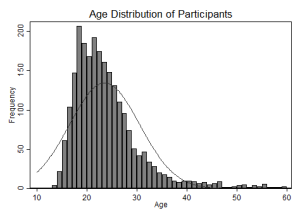
- Relatively high levels of education

- Mainly male

- Mainly heterosexual

- Longest streak: 47.73 (s.e. 1.88) days on average
- Length of current streak when participating in the survey: 15.95 (s.e. 1.14) days on average
- Most participants state being highly addicted to porn / masturbation / porn & masturation
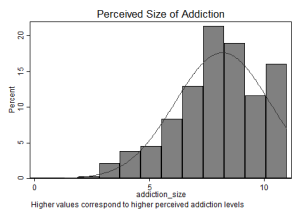
- Addicted participants are less willing to take risks (dark gray bars)
- Addicted participants are less able to delay rewards (light gray bars)

Effects of Abstinence
- After a period of abstinence (“rebooting“), participants become more able to delay rewards
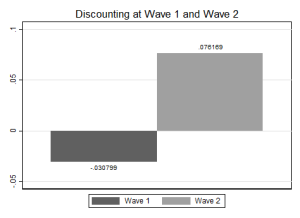
- After a period of abstinence, participants become less risk averse
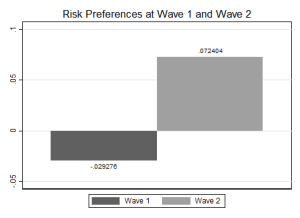
- Abstinence renders participants more willing to punish if others are treated unfairly: Altruistic punishment increases
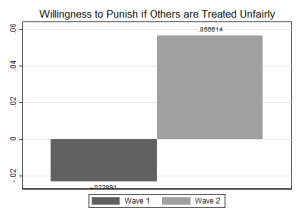
- After a reboot people get
- less neurotic (dark gray)
- more extroverted (light gray)
- more conscientious (third bars)
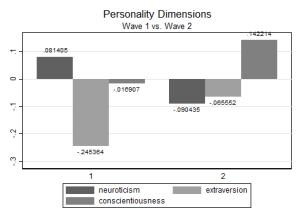
A full summary of the questionnaire and results can be found here: NoFap Report 20160104 and here: Overview 20160104.
